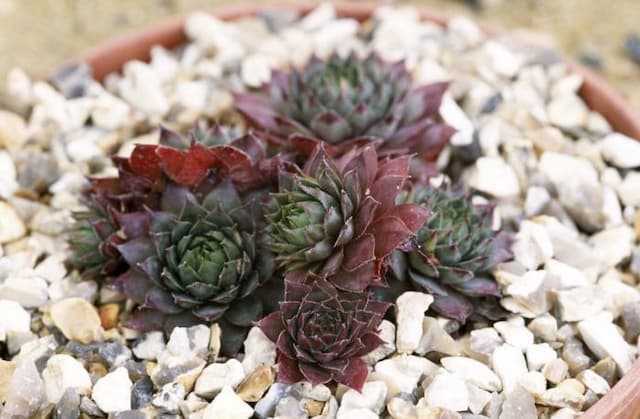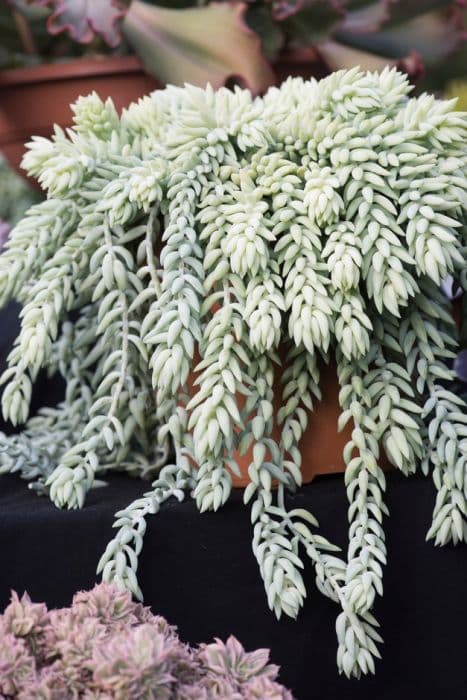Mexican Snowball Echeveria elegans



ABOUT
Echeveria is a perennial herbaceous plant 2-4 inches high and 20 inches wide. It is succulent plant with stiff and fleshy leaf plates assembled in dense rosettes. The foliage is light green, which does not change throughout the growing season.
One of the differences of this species from its closest relatives is a transparent white plaque on the surface of the leaves.
Do not try to remove the plaque or wash it off - it does not have the property of regeneration. Without it, the plant will lose its decorative appearance and may fall ill.
About this plant
 Names
NamesFamily
Crassulaceae
Synonyms
Mexican snow ball, Mexican snowball, Mexican gem, White mexican rose, Hens and Chicks, Pearl echeveria
Common names
Echeveria tinctoria, Echeveria tinctorum, Echeveria potosina, Echeveria albikans
 Toxicity
ToxicityTo humans
Non-toxic but avoid ingesting. May cause personal intolerance if ingested or if it comes into contact with the skin.
To pets
Non-toxic but avoid ingesting them and keep them away from pets. May cause personal intolerance if ingested.
 Characteristics
CharacteristicsLife cycle
Perennials
Foliage type
Evergreen
Color of leaves
Light green with transparent white plaque
Flower color
Pink with yellow tips
Height
4 inches
Spread
20 inches
Plant type
Succulents
Hardiness zones
8
Native area
Mexico
Benefits
 General Benefits
General BenefitsVery decorative;
Easy to care for, as the plant is very hardy;
Easily tolerates infrequent watering;
Easy and quick to propagate. Medical Properties
Medical PropertiesIt is not currently used, but is undergoing laboratory researches.
The results indicate their potential and the possibility of using them for the manufacture of modern drugs. Therefore, further studies are needed to confirm their antimicrobial, antihyperglycemic, anti-inflammatory and anthelminthic activities.
Interesting Facts
 Feng Shui
Feng ShuiAccording to Feng Shui for proper energy Echeveria should be healthy. It is not recommended to keep a withered Echeveria in the house. Also, an old plant that has not given young shoots for a long time should be discarded.
In order for the Echeveria to manifest its energy in full force, it should be placed on the southwestern side of the house. Preference should be given to a lighted window sill or balcony. Zodiac Sign Compitability
Zodiac Sign CompitabilityVIRGO
Virgo is often faced with stress. Fortunately, most succulents are pretty easy on the eye, the wallet and in terms of care. For the Virgo who wants to have a good time with a good succulent, the Echeveria elegans is made for you.
 Water
WaterIn summer 2 - 3 times a month. In winter approximately 1 time a month (depends on the rate of soil drying).
Echeveria should be watered after the soil dries out completely, the water should be left out for 2 - 3 days before that. The lack of moisture can be indicated by the leaves - they become sluggish and wrinkled. Watering should be abundant. Light
LightThe plant needs bright indirect sunlight. Young plants are accustomed to bright light gradually, to avoid death.
In winter it needs additional lighting. Lack of light affects the quality of the leaves and overgrowing in height of its stem. Temperature
TemperatureIn summer no more than 86 ºF;
In winter perfect temeratures - 65-70 ºF. However, can survive a frost of 21 degrees (but it is better not to get to that). Pruning
PruningOften, because of the lack of light during the winter, echemeria grows very tall. Because of this, it is necessary to renew the plant by pruning. This is done in the spring. It is necessary to cut off the top of the plant, leaving a 1,5 inches high of the stem. New shoots will grow quickly.
 Cleaning
CleaningNot needed
 Soil
SoilThe soil mix should be made of sod and leaf soil with the addition of sand and brick crumbs in a ratio of 3:1:1:1. You can use a specialized soil mixture for succulents. Drainage is necessary.
 Repotting
RepottingAs long as the plant is young (up to 5 years old), it is transplanted annually in the spring. Older specimens are transplanted once every 3 or 4 years, also in spring or summer.
 Humidity & Misting
Humidity & MistingMisting is forbiden. The plant loves dry air.
 Suitable locations
Suitable locationsIndoor
All year round
Outdoor
Can be taken outside when temperatures are not between 65 - 90 ºF.
Despite the fact that the plant can tolerate temporary drops in temperature down to 21 ºF, you should not take risks and take your plant into a warm room in time.Hardiness zone
9 - 11 USDA
 Life cycle
Life cycleThe flowers of Echeveria are beautiful, rosy-orange in color. They appear from May to June. The blooms last about 20 days.
 Propogation
PropogationPropogation time
Spring
The most common propagation option is by leaves.
The lower healthy and sturdy leaves are cut off or broken off gently.
The leaf should be dried: thin leaf - 2-3 hours, thick - 2-3 weeks.
In the pot, the bottom layer is placed small pebbles, then the soil. The leaves are placed at an angle, slightly pressing. The soil need to be moistened with a sprayer, the pot need to be covered to make a greenhouse effect. The pot should be aired daily. Moisturize the soil as it dries completely.
Two to three weeks later the young sprouts appear. They are transplanted after the mother leaf has dried out.
The only disadvantage of this method is the time.
 Pests
PestsMealybug, Aphid
 Diseases
DiseasesRoot Rot









